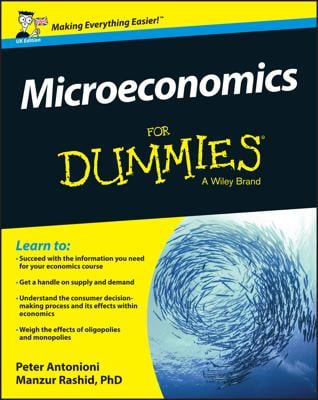The cross-price elasticity of demand measures the responsiveness of a good’s demand to changes in the price of a second good. In managerial economics, this relationship is crucial because the amount of your good customers purchase is influenced by the prices rival firms charge for similar goods. Also, the price you charge for one good — hamburgers, for example — influences the amount you sell of a second good, french fries.
How to determine the cross-price elasticity of demand
Calculating the cross-price elasticity of demand requires determining how good x’s demand changes in response to a different price for good y.
The cross-price elasticity of demand’s formula is

Note how similar this formula is to other elasticity formulas. In this case, the symbol ηx,y represents cross-price elasticity of demand. The x represents the good whose quantity is changing, and the y represents the good whose price is changing.
So, in the formula, the symbol Qx0 represents the initial demand or quantity purchased for good x when the price of good y is Py0. The symbol Qx1 represents good x’s new demand when good y’s price changes to Py1.
As with all elasticity values, the larger the number (either positive or negative), the more flexible or responsive quantity is. For the cross-price elasticity of demand, a larger number indicates good x’s demand will change a lot when good y’s price changes.
Your vending machine company currently sells soft drinks at $1.50 per bottle, and at that price, customers purchase 2,000 bottles per week. At the same time, a local convenience store sells the same soft drinks for $1.25 per bottle. The convenience store decides to run a special and lowers the price of soft drinks to $1.00 per bottle. As a result, your sales decrease to 1,800 bottles per week.
You didn’t change the vending machine price for soft drinks, but your sales decreased due to the convenience store’s sale. The cross-price elasticity of demand will tell you how responsive your vending machine soft drink sales are to the change in price at the convenience store.
Here’s what you do to determine how much the convenience store’s sale affects your demand:
Because $1.25 is the initial price of soft drinks at the convenience store (good y), and 2,000 is quantity of soft drinks sold in vending machines (good x), put $1.25 into Py0 and 2,000 into Qx0.
Because $1.00 and 1,800 are the new price for good y (convenience stores) and quantity for good x (vending machines), put $1.00 into Py1 and 1,800 into Qx1.
Divide the expression on top of the equation.
(Qx1 – Qx0) equals –200, and (Q1 + Q0) equals 3,800. Dividing –200 by 3,800 equals –1/19.
Divide the expression in the bottom of the equation.
(Py1 – Py0) equals –$0.25, and (Py1 + Py0) equals $2.25. Dividing –$0.25 by $2.25 equals –1/9.
Divide the top result, –1/19, by the bottom result, –1/9.
You get the cross-price elasticity of demand 9/19 or 0.474.
So the cross-price elasticity of demand for soft drinks equals

The cross-price elasticity of demand tells you a 1 percent decrease in the price of good y, the convenience store soft drink, causes a 0.474 percent decrease in demand for soft drinks from vending machines. Vending machine sales are not affected very much by changes in convenience store prices.
Substitutes and complements
Substitutes are goods that are used interchangeably — one is used in the place of another. Think of potato chips and pretzels. Thus, an increase in the price of one good, good y, causes an increase in the quantity consumed of the second good, good x. This change occurs because customers will tend to switch to the lower priced good.
So, an increase in the price of potato chips, good y, means customers will switch and purchase more of good x, pretzels. Thus, a direct relationship exists between the price of good y and the demand for good x, and they are substitutes.
Complements are goods that are used together, such as coffee and cream. For complements, an inverse relationship exists between good y’s price and good x’s demand; if good y’s price increases, the demand for good x decreases and vice versa. So, if the price of coffee increases, good y, you drink less coffee, and your demand for cream, good x, decreases.
Finally, the larger the value, either positive or negative, for the cross-price elasticity of demand, the stronger the relationship between the two goods.

